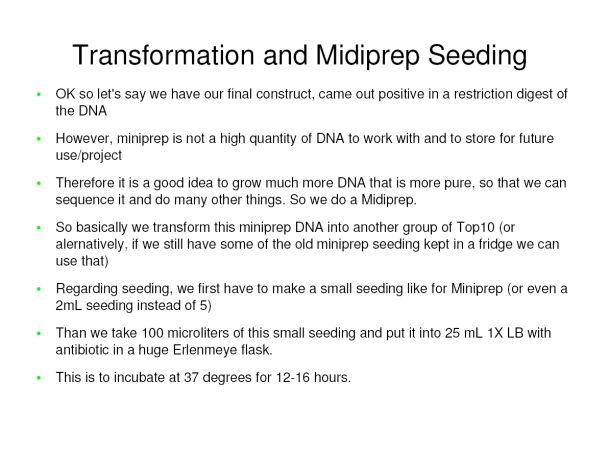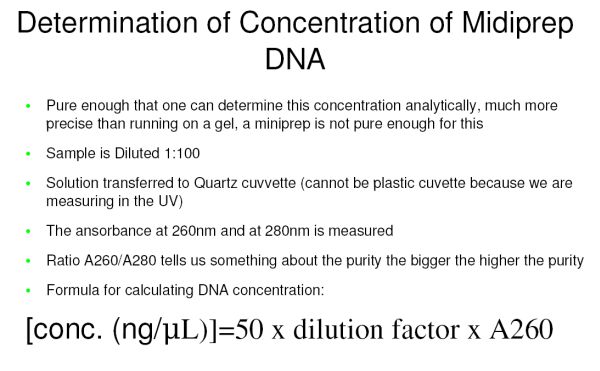McGill/Midiprep Seeding
From 2007.igem.org
(Difference between revisions)
| Line 8: | Line 8: | ||
#Pellet the bacteria in a desktop clinical centrifuge, 10-15 min. at medium setting should do it. (You should have that kind of centrifuge on the C-floor, it might take either 50ml tubes or 15ml tubes seem to be more efficient. Hint - if you don't see a pellet it was too short/too slow. These guys will settle out at room temperature eventually, so if you have a wimpy centrifuge don't worry, just add more time. | #Pellet the bacteria in a desktop clinical centrifuge, 10-15 min. at medium setting should do it. (You should have that kind of centrifuge on the C-floor, it might take either 50ml tubes or 15ml tubes seem to be more efficient. Hint - if you don't see a pellet it was too short/too slow. These guys will settle out at room temperature eventually, so if you have a wimpy centrifuge don't worry, just add more time. | ||
#Decant supernatant, drain well, pool all pellets of the same type into 5ml buffer P1. Make sure RNAse A and LyseBlue (included) were added to P1. Distribute the mix along 10 microfuge tubes, 500ul each. | #Decant supernatant, drain well, pool all pellets of the same type into 5ml buffer P1. Make sure RNAse A and LyseBlue (included) were added to P1. Distribute the mix along 10 microfuge tubes, 500ul each. | ||
| - | #To each microfuge tube, add 500ul buffer P2, mix by inverting several times (do not vortex). Do one tube at a time (add, mix, go to next tube, add mix...). You it's mixed when it turns from white/beige to uniformly blue - no white streaks allowed. | + | #To each microfuge tube, add 500ul buffer P2, mix by inverting several times (do not vortex). Do one tube at a time (add, mix, go to next tube, add mix...). You know it's mixed when it turns from white/beige to uniformly blue - no white streaks allowed. |
#Leave at room temperature 5 minutes. By the time you get to tube 10, it may be close for the time to start the next step (#8) for tube 1. | #Leave at room temperature 5 minutes. By the time you get to tube 10, it may be close for the time to start the next step (#8) for tube 1. | ||
#Add 50ul buffer P3, mix by inverting as above. Do one tube at a time, same order as above. A white precipitate should form and all the blue should disappear. | #Add 50ul buffer P3, mix by inverting as above. Do one tube at a time, same order as above. A white precipitate should form and all the blue should disappear. | ||
Revision as of 21:59, 3 June 2007
- Set up 50ml of 1xLB with 100 ug/ml antibiotic of your choice.
- Pen-strep should be at 100mg/ml stock so use 50ml per 50 ml.
- Kanamycin should be at 10mg/ml (it's poorly soluble) so use 500 ul per ml NOTE - for low copy number plasmids, increase total culture volume to 100ml.
- Distribute the LB/antibiotic mix into 50ml-tubes (25ml in each). This gives room to aerate.
- Add 250ul overnight culture (from a 5ml prep) to each tube, incubate on the shaker at 37C overnight.
- Pellet the bacteria in a desktop clinical centrifuge, 10-15 min. at medium setting should do it. (You should have that kind of centrifuge on the C-floor, it might take either 50ml tubes or 15ml tubes seem to be more efficient. Hint - if you don't see a pellet it was too short/too slow. These guys will settle out at room temperature eventually, so if you have a wimpy centrifuge don't worry, just add more time.
- Decant supernatant, drain well, pool all pellets of the same type into 5ml buffer P1. Make sure RNAse A and LyseBlue (included) were added to P1. Distribute the mix along 10 microfuge tubes, 500ul each.
- To each microfuge tube, add 500ul buffer P2, mix by inverting several times (do not vortex). Do one tube at a time (add, mix, go to next tube, add mix...). You know it's mixed when it turns from white/beige to uniformly blue - no white streaks allowed.
- Leave at room temperature 5 minutes. By the time you get to tube 10, it may be close for the time to start the next step (#8) for tube 1.
- Add 50ul buffer P3, mix by inverting as above. Do one tube at a time, same order as above. A white precipitate should form and all the blue should disappear.
- Leave tubes on ice for 10 min.
- Centrifuge tubes in a microfuge at max speed for 10 min.
- Pool all supernatants into a 15ml tube. Pipet with P1000, do not pour, do not be greedy (ie. take liquid only, no white chunks).
- If there are chunks, re-aliquot into clean microfuge tubes. There will be fewer tubes than before. Re-centrifuge, pool supernatants into another clean 15ml tube. If there are no chunks, go on to step 13.
- Pre-equilibrate a midiprep column with 5ml QBT buffer.
- When all the buffer has gone through, pour on your cleared bacterial lysate from step 12.
- When all the sample has gone through, pour the column full of QC Buffer (no need to measure, just fill right to the top). Allow to drain, repeat once.
- When all the QC buffer has gone through, MOVE THE COLUMN TO A CLEAN 50ml TUBE, then apply 5ml buffer QF. THIS STEP ELUTES THE DNA.
- Add 3.5ml isopropanol to the eluted DNA, distribute among six microfuge tubes, centrifuge at max speed for 10 min.
- Decant supernatant, pipet off any remaining liquid with a p-10 tip, air dry 10 min.
- Resuspend in EB or TE or in 10mM Tris pH8.0, recommended volumes: tiny pellet (barely visible) 25ul, medium pellet 50ul, huge pellet 100uL.
- To measure the O.D. 260/280, usually 4ul in 400ul water is ok.

